Career Trends HUMAN CAPITAL HUMAN CAPITAL
AVIATION AVIATION
Luis Felipe de Oliveira, ACI World and Captain Marcelo Brandão give us their experts' perspectives.
SHIPBUILDING
Andre Merlino and Danilo Dias reinforce the need for innovation, automation, and the best advice to grow your career.
HUMAN RESOURCES

Carlos Alberto Griner, Embraer and international best-seller author Laurie Riker, Hayman-Woodward Group share how they are transforming their teams for better.
Pilots & Air Traffic Controllers: no short-term solution for a strategic problem?
WE CELEBRATE
Pride Month, Leonardo Freitas
4th of July, Ana Paula Montanha
STORY READ NOW !
Governor Glenn Youngkin is piloting the Virginia's economic growth


O n l i n e I S S N 2 7 7 19 1 4 6 | P r i n t I S S N 2 7 7 19 1 3 8 M A Y | J U N E 2 0 2 2
YOU'RE INVITED TO THE YOU'RE INVITED TO THE GRAND OPENING GRAND
Please join us in celebrating our Inaugural ceremony on Thursday,14TH JULY 2022 RSVP for more information: HC@HW.IM


14 14 JULY JULY tth h
HW HW
OPENING ORLANDO ORLANDO






INTERNATIONAL CAREER SERVICES AND BUSINESS PLANNING LEADERS HUMAN CAPITAL SERVICES | MANAGEMENT CONSULTING
Leonardo Freitas Founder, Chairman and CEO
Danilo Dias COO
Ana Paula Montanha Co-Founder, Managing Partner
CONTENTS CONTENTS





4
INDUSTRY EXPERTS

Leadership Thought
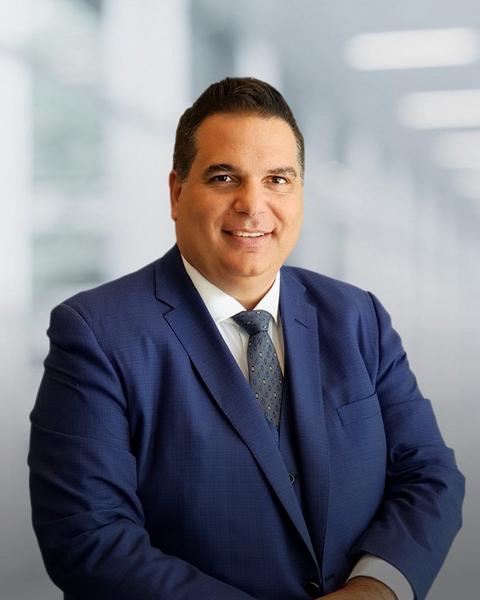





We're genuinely grateful for your support, and we know that your knowledge and experience will make a difference in the lives of our readers.

Human Capital | Career Trends 5
Luis Felipe de Oliveira, Director General, ACI World
Andre Merlino, Global Senior Executive, Energy expert
Carlos Alberto Griner, Vice President of People, ESG and Corporate Communications, Embraer
Captain and Pilot Marcelo Brandão
Laurie Riker, Vice President of People and Culture, Hayman-Woodward
Danilo Dias, our COO, Infrastructure expert
Leonardo Freitas, our CEO, Business Immigration expert
1010 Vermont Avenue NW, Suite 810 - Washington, DC 20005, USA Human Capital Career Trends Magazine Human Capital Career Trends | 5
Career Trends HUMAN CAPITAL
EDITOR IN CHIEF Ana Paula Montanha CEO Leonardo Freitas CHIEF OPERATING OFFICER Danilo Dias
MAGAZINE JOURNALIST & MARKETING DIRECTOR Elaine Dotto BUSINESS DEVELOPMENT DIRECTOR Luiz Franca
Human Capital Career Trends Magazine (Online ISSN 2771-9146 | Print ISSN 2771-9138) is an American national magazine focused on career trends, immigration, and society, published six times per year on a bi-monthly basis, it is published by Hayman-Woodward Human Capital Services.
Human Capital Magazine considers its sources reliable and verifies as much data as possible, although reporting incarnates can occur; consequently, readers using this information due so at their risk
Human Capital Magazine is sold with the understanding that the publisher is not rendering legal services or financial advice. The views expressed in the articles reflect the author's (s) opinions and do not necessarily are the views of the publisher and editor The published material, adverts, editorials, and all other content is published in good faith Human Capital Magazine cannot guarantee and accepts no liability for any loss or damage of any kind caused by this website and errors and for the accuracy of claims made by the advertisers.
All rights reserved, and nothing can be partially or in whole reprinted or reproduced without written consent All rights reserved No part of any Human Capital Magazine published work may be reproduced, stored in a retrieval system, or transmitted in any form or by any means, electronic, mechanical, photocopying, recording, or otherwise, without written permission from the publisher.
Human Capital Magazine reserves the right to change any information on these articles without notice
By reading this magazine, you agree to all terms and conditions listed above. If you have any questions about this policy, you may contact us.
Customer Services: customerservice@humancapitalcareertrends com
Subscription: subcribe@humancapitalcareertrends com
Editorial: info@humancapitalcareertrends.com
Domain: https://hwhuman.capital/career-trends/ 1010 Vermont Avenue NW, Suite 810 - Washington, DC 20005, USA

6 | Human Capital Career Trends
NÃO É POSSÍVEL PLANEJAR SUA CARREIRA INTERNACIONAL COM UM ANÚNCIO.
Mas com a Hayman-Woodward Human Capital Services

você pode. Agende sua consulta e realize seu sonho profissional de morar fora do país exercendo sua profissão.
Marque sua consulta hoje, em Português com os nossos consultores, líderes de indústrias.
Use o QR code para saber mais sobre os nossos serviços e agendar sua consulta.
Human Capital Career Trends | 7
Ana Paula Montanha, Editor-in-Chief
ON A MISSION TO BUILD A BETTER AMERICA: ATTRACT AND RETAIN NATIONAL INTERESTS AND ESSENTIAL WORKERS.
We are on a mission to build an America to which no one could say no, as we seek to attract and retain our national interests and essential workers
Like the 1918 influenza pandemic, referred to as the "Spanish Flu," the COVID-19 pandemic became a primary concern in peoples' lives over the last three years, affecting and disrupting virtually every aspect of our society cast its shadow all over the world. The far-reaching consequences were political, social, and emotionally devastating.
Accordingly, the Biden-Harris administration prioritized the safety of American citizens, COVID-19, economic recovery, racial equity, and climate change. In times of economic, technological, and political transformation, successful strategy leaders and policymakers such as these understand their choices' impact on America's future
Whenever there is a unique opportunity, we need a solid strategy and a clear path to progress from which to benefit. In a 1959 speech, John F. Kennedy famously said: "When written in Chinese, the word 'crisis' is composed of two characters: one represents danger, and one represents opportunity."
While today it is widely recognized that this is not an accurate interpretation of these Chinese characters, President Kennedy's wisdom about a crisis yielding unique opportunities may be more critical than ever
As CEOs, Founders, and Entrepreneurs, we are strategists who spend our days attempting to predict, prevent, and prepare for potential crises across all domains of our respective organizations
In the same way, our elected officials, political appointees, and national security officers define and review guidelines from political and economic arenas to those involving the military and security from terrorism.
The more we understand what we want from these things and how they play a role in our larger vision of our future and our society, the better we can decide if there is something we need to do now, later, or never.
There are excellent opportunities ahead of us, but to benefit from them, we need to have the people and the infrastructure in place to take advantage and build the tomorrow of our dreams
All Americans must understand and collaborate on these critical topics, assisting our governments in defining our national interests and essential workers.
Plato.

Human Capital | Career Trends
4TH OF JULY 6
HAPPY
"Necessity is the mother of invention.”
8 | Human Capital Career Trends
Often, a crisis acts as a mechanism to compel expeditious innovation, leading to rapid technological, policy, and procedure advances. The covid-19 pandemic has proven to be no different in this regard

We dedicate this issue to these crucial workers, including but not limited to pilots, aerospace, aviation, and defense; oil, gas, wind, and solar energy; and global positioning systems, information technology, cybersecurity engineers, and shipbuilders, who innovate and transform our lives.





In a world where countries compete for essential workers’ talents, we need to build an America to which high-skilled professionals and essential workers can not say no.
 Ana Paula Montanha Editor-in-Chief
Ana Paula Montanha Editor-in-Chief

www linkedin com/in/anamontanha @anapaulamontanhaoficial
https://hwhuman capital

Mrs Montanha is a seasoned executive and entrepreneur She co-founded Hayman-Woodward Human Capital Services and serves as Managing Partner Mrs Montanha holds a master’s in business administration from Stephen M Ross School of Business, the business school of the University of Michigan, a graduate degree in marketing, and a bachelor’s in economics.
NATIONAL INTERESTS AND ESSENTIAL WORKERS
"Great leadership is all about inspiring people, serving people, caring for people, and mostly now truly caring about your people. Your team, people, and company collaborators are your essential workers. Tell them you care, show them there are essential to you."

 Ana Paula Montanha.
Ana Paula Montanha.
Human Capital Career Trends | 9
DO SOMETHING TODAY DO SOMETHING TODAY THAT YOUR FUTURE SELF THAT YOUR FUTURE SELF WILL THANK YOU FOR. WILL THANK YOU FOR.
Your actions and decisions today will shape the way we will be living in the future.
LEADERS IN SME BUSINESS PLANS, IMMIGRATION BUSINESS PLANS, AND BUSINESS ADVICE.


LEONARDO FREITAS
 CEO, Hayman-Woodward
CEO, Hayman-Woodward
DIGNITY, AND RESPECT
Leonardo Freitas, CEO
"Pride Month" offers us a unique opportunity to reflect on the progress we have made as a Nation in the fight for justice, inclusion, and equality while reaffirming our commitment to do more to support LGBTQI+ rights at home and abroad.

It has been over 25 years since Fidel Armando Toboso Alfonso, a gay man from Cuba, was granted withholding deportation in the United States based on his sexual orientation (1)
The Toboso-Alfonso decision paved the way for hundreds of lesbian, gay, bisexual, and transgender individuals and individuals with intersex conditions (LGBTQI+) to obtain refugee and asylum status in the United States. In 2011, the United Nations marked another "significant milestone in the long struggle for equality, and the beginning of a universal recognition that LGBT[LGBTQI+] persons are endowed with the same inalienable rights – and entitled to the same protections – as all human beings" (2) by passing a Resolution on Human Rights, Sexual Orientation, and Gender Identity
In 2013, the Supreme Court held that section 3 of the Defense of Marriage Act, which had limited the terms "marriage" and "spouse" to opposite-sex
marriage for purposes of federal law was unconstitutional (3) Then, in 2015, the Supreme Court struck down state laws denying marriage licenses to couples of the same sex, legalizing same-sex marriage throughout the United States (4) Legally valid marriages between couples of the same sex are now treated the same as all other marriages under the Immigration and Nationality Act (INA) for all purposes, including the processing of derivative refugees and asylees under INA 207 and 208. (5)
Refugee, Asylum, and International Operations Directorate (RAIO Directorate) officers are trained to interview LGBTQI+ applicants and analyze their claims. This training increases awareness about the issues "sexual minorities" face, fosters discussion about LGBTQI+ issues, and provides consistent legal and interview guidance
Officers are specifically trained in the interview environment that allows applicants to freely discuss the elements and details of their claims and identify issues related to sexual orientation or imputed sexual orientation. The training prepares them (adjudicating officers) to interact more meaningfully with LGBTQI+ applicants during an interview. They must also become well-versed in the country of origin information, allowing these officers to ask relevant follow-up questions.
LGBTQI+ people face generalized and unique vulnerabilities that cause many to leave their country of origin and seek refuge in another. Consensual same-sex conduct remains criminalized in 69 countries, and 11 countries could impose the death penalty if convicted
7
12 | Human Capital Career Trends
Such legal contexts are associated with lower social acceptance of LGBTQI+ people, which can marginalize individuals' sexual orientation or gender identity and create environments that fuel violence and discrimination against LGBTQI+ people based on fear and stigma.
Even where same-sex conduct is not criminalized, research shows that many LGBTQI+ people face persecution and violence, including domestic violence, rape, and murder, as well as discrimination in areas like education, employment, housing, and healthcare.
LGBTQI+ people who are excluded from housing and employment through discrimination may be forced to take jobs in the informal economy, such as sex work, where they may be more vulnerable to exploitation and violence.
Little information exists about the number and characteristics of LGBTQI+ asylum seekers in the United States

Using Asylum Prescreening System data from the United States Citizenship and Immigration Service (USCIS), a report released on March 2021 by UCLA - The Williams Institute, a leading research center on sexual orientation and gender identity law public policy, gives us some insights. Between 2007 and 2017, at least 4,385 fear claims that led to interviews by asylum officers were coded as related to LGBTQI+ status.
While claimants originated from 84 countries, over half (51.3%) were from the Northern Triangle region of Central America: El Salvador (28.0%), Honduras (14.9%), and Guatemala (8.4%). Significant proportions also were from Mexico (12.1%) and Ghana (7.8%).

Note: The 2021 USCIS Statistical Annual Report has not been published
HOMOSEXUALITY IS
IS CRIMINALIZED IN 69 CRIMINALIZED IN 69 COUNTRIES AND AS COUNTRIES AND AS MANY AS 11 MANY AS 11 COUNTRIES COULD COUNTRIES COULD IMPOSE THE DEATH IMPOSE THE DEATH PENALTY IF PENALTY IF CONVICTED. CONVICTED.
EVEN WHERE SAME-SEX CONDUCT IS NOT CRIMINALIZED, RESEARCH SHOWS THAT MANY LGBTQI+ PEOPLE FACE PERSECUTION AND VIOLENCE, INCLUDING DOMESTIC VIOLENCE, RAPE, AND MURDER, AS WELL AS DISCRIMINATION IN AREAS LIKE EDUCATION, EMPLOYMENT, HOUSING, AND HEALTHCARE.
HOMOSEXUALITY
Human Capital Career Trends | 13
According to the 2020 USCIS Statistical Annual Report:

Mexico” immigration policy originated under the Trump administration. The ruling was 5-4 and states that immigration law gives the federal government the discretion to end the program, formally known as Migrant Protection Protocols.
Writing for the majority, Chief Justice John Roberts said that the relevant immigration statute “plainly confers a discretionary authority to return aliens to Mexico during the pendency of their immigration
USCIS received about 7.7 million applications, petitions, and requests for benefits in fiscal year (FY) 2020, the lowest number of receipts in the last five years This decrease was by a significant decline in receipts during the beginning of the COVID-19 pandemic in the spring of 2020 when USCIS closed field offices to the public

The number of credible fear referrals received by USCIS decreased dramatically in FY 2020 by 71% from FY 2019, from 105,400 to 30,800. Likewise, the number of screenings completed by USCIS officers also fell in FY 2020 from a high in FY 2019 of 102,300 to 33,600 in FY 2020. Similarly, the number of reasonable fear referrals received fell in FY 2020 to 8,700 (down from 11,100 in FY 2019); USCIS officers completed 7,500 reasonable fear cases, down from 11,800 in FY 2020.
On June 30th, 2022, as we close this edition of our magazine, the SCOTUS gave President Joe Biden the green light to end the controversial “Remain in
“The use of the word ‘may” in” the law question, Chief Justice John Roberts wrote, “makes clear that contiguous-territory return is a tool that the (DHS) Secretary ‘has the authority, but not the duty,’ to use ” In the coming months, we expect additional information and clarity on the next steps, although undoubtedly good news for LGBTQI+ asylum seekers.
The Department of Homeland Security said in a statement Thursday, June 30th, 2022, that it welcomed the Supreme Court’s decision that it “has the discretionary authority to terminate the program, and we will continue our efforts to terminate the program as soon as legally permissible.”
In the statement, DHS also said it will continue to punish immigrants who enter the country illegally and enforce Title 42, the emergency health order that immigration officials have used to quickly expel a majority of people attempting to enter the country
14 | Human Capital Career Trends
In the statement, Alejandro Mayorkas, the DHS secretary, said, “after a thorough review, the prior administration’s Migrant Protection Protocols (MPP) has endemic flaws, imposes unjustifiable human costs, and pulls resources and personnel away from other priority efforts to secure our border ”
As we close this edition, the Department of Homeland Security’s Office of the Citizenship and Immigration Services Ombudsman (CIS Ombudsman) submitted its annual report to Congress, which provides recommendations for creating a more effective and efficient system. Highlights of the 2022 Annual Report include studies of USCIS’s affirmative asylum backlog which now stands at over 430,000 cases and recommendations for new operational approaches to improve the quality and efficiency of asylum adjudications.
Leonardo Freitas is the Founder, Chairman, and CEO of Hayman-Woodward; Mr. Leonardo Freitas explains recent immigration trends and why 2022 may be the year for qualified professionals to relocate to the United States

Leonardo Freitas is our columnist on entrepreneurship, highskilled workforce, global mobility, and related immigration issues
Note: The 2021 USCIS Statistical Annual Report has not been published
https://www uscis gov/tools/reports-and-studies/semi-monthly-credible-fear-and-reasonable-fear-receipts-and-decisions
https://www uscis gov/sites/default/files/document/reports/2020-USCIS-Statistical-Annual-Report pdf
https://williamsinstitute law ucla edu/publications/lgbtqi-refugee-convening/ https://williamsinstitute law ucla edu/wp-content/uploads/Asylum-LGBT-Claims-Mar-2021 pdf
https://www dhs gov/news/2022/06/30/dhs-statement-supreme-court-decision-mpp https://www dhs gov/news/2022/07/01/citizenship-and-immigration-services-ombudsman-submits-annual-report-congress
Leonardo Freitas
Human Capital Career Trends | 15
FOR NOW, LET'S ALL WORK TO MAKE AMERICA A COUNTRY OF LIBERTY AND EQUALITY. MAY AMERICA BE DEFINED AS A COUNTRY THAT OFFERS PEOPLE POSSIBILITIES. MAY THIS MONTH BE ANOTHER OPPORTUNITY TO REMIND THE LGBTQI+ COMMUNITY THAT THEY ARE LOVED AND CHERISHED AND, MOST IMPORTANTLY, THAT THEY DESERVE DIGNITY, RESPECT, AND SUPPORT.



Hayman Woodward leads the charge on issues related to Talent Management. We recruit, empower and nurture leaders to develop core competencies and create a roadmap for everyone to unlock their unique potential.
We strive towards an equitable, diverse, inclusive, and accessible work environment where all our employees feel welcomed and motivated to come to work.
Retaining a highly skilled workforce for American companies by hiring the right employees for the correct positions and providing opportunities for professional growth is essential to the strategic success of U.S.-based companies.
ALL ALL TOGETHER TOGETHER IISWHERE SWHERE WE WE BELONG BELONG
Thankyoutoalltheessentialworkerswhokeepour countryrunningduringthesechallengingtimes.We knowit'snoteasy,andweareproudofyour dedicationandhardwork.
Wethankouremployees.We'regratefulfor everythingyoudotohelpussucceed.
Wecouldn'tdoitwithoutyou!
1010 Vermont Avenue NW, Suite 810, Washington, DC 20005, USA Office: +1 (202) 753-4133 | E-mail: HC@HW.IM HAYMAN-WOODWARD HUMAN CAPITAL SERVICES HUMAN CAPITAL SERVICES | MANAGEMENT CONSULTING
Human Capital Career Trends | 17
16 Meet the sixteen critical infrastructure sectors
There are 16 critical infrastructure sectors (1) whose assets, systems, and networks, whether physical or virtual, are considered so vital to the United States that their incapacitation or destruction would have a debilitating effect on security, national economic security, national public health or safety, or any combination thereof.
During our editions, we will discuss their momentum and future perspectives to inspire your calling and career growth. In this edition, we did a deep-dive into two of the most promising ones in the transportation system sector: aviation and maritime transportation systems.
NATIONAL IMPORTANCE | ISSUE NO. 2
18 | Human Capital Career Trends
THE CRITICAL INFRASTRUCTURE SECTOR
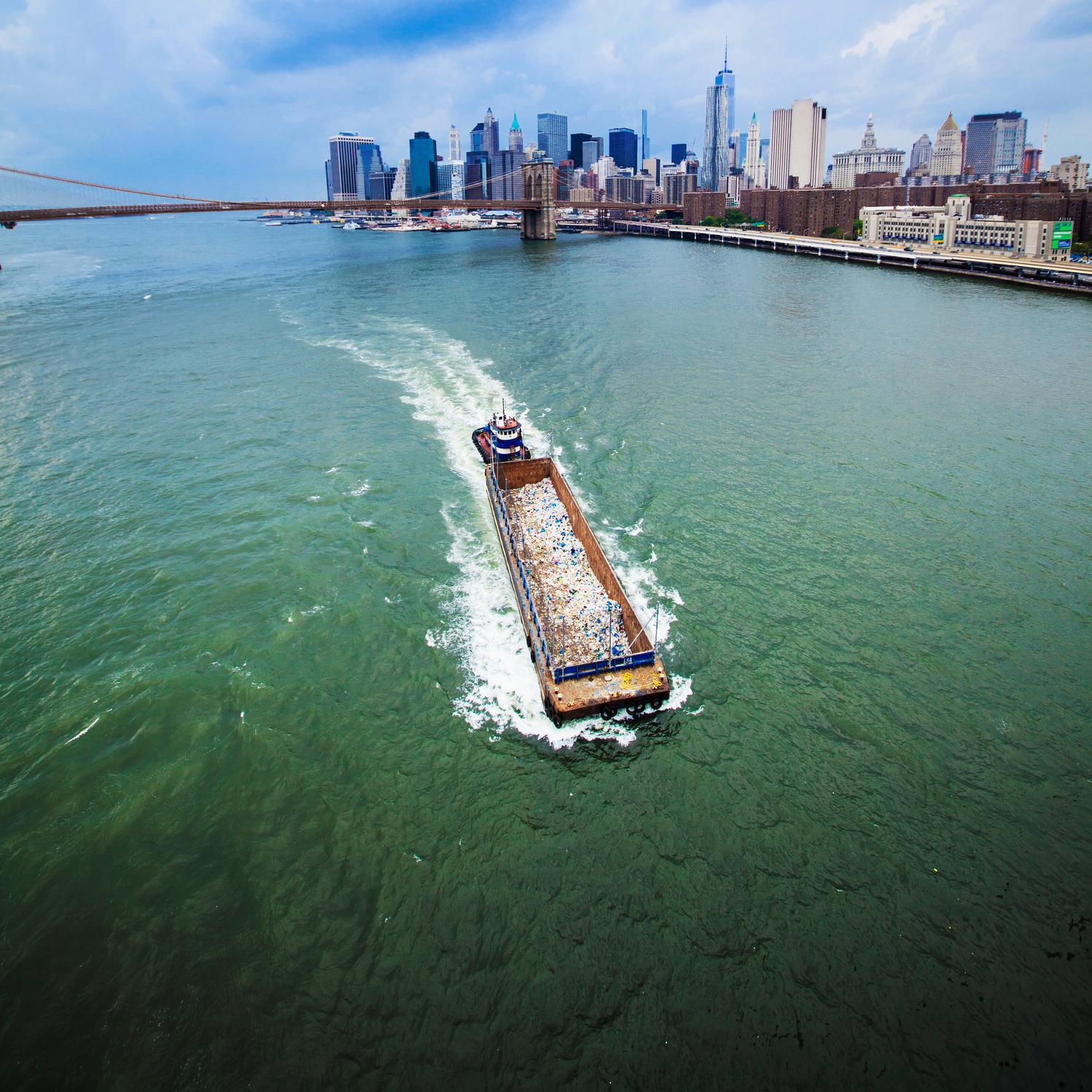

NATIONAL IMPORTANCE - SPECIAL COVERAGE
Ana Paula Montanha; Editor-in-Chief, Luiz Franca, Executive Producer; and Journalist, Elaine Dotto.
During the Pandemic shutdown, many American workers had to put their health and lives on the line working in industries critical to keeping our nation running due to the COVID-19 epidemic.
Those frontline workers worked in a j b th t required them to work outside their hom themselves at risk of exposure, regardles at home" orders
ECONOMY,
According to the U.S. Department of H Security, essential workers conduct a operations and services that are typically to continue critical infrastructure op Critical infrastructure is an effective umb encompassing sectors from energy to d agriculture.
“Essential workers” as those who condu of operations and services in industries that are essential to ensure the continuity of critical functions in the United States (U.S.). Essential workers were initially described by the U.S. Department of Homeland Security’s Cybersecurity and Infrastructure Security Agency (CISA): “Guidance on the Essential Critical Infrastructure Workforce: Ensuring Community and National Resilience in COVID-19 Response, (Version 4.0; August 18, 2020)external icon.”

IN THE MODERN
ARE MANY TYPES OF EMPL REQUIRED TO SUSTAIN NORMA TO-DAY SERVICES THAT ENAB ECONOMY AND OUR WAY OF LIF
Human Capital Career Trends | 19
This list maps the CISA guidance to standardized industry codes and titles for ease of use. As defined by the U.S.A. Patriot Act of 2001 (42 U.S.C. 5195c(e)), critical infrastructure includes any:
“SYSTEMS AND ASSETS, WHETHER PHYSICAL OR VIRTUAL, SO VITAL TO THE UNITED STATES THAT THE INCAPACITY OR DESTRUCTION OF SUCH SYSTEMS AND ASSETS WOULD HAVE A DEBILITATING IMPACT ON SECURITY, NATIONAL ECONOMIC SECURITY, NATIONAL PUBLIC HEALTH OR SAFETY, OR ANY COMBINATION OF THOSE MATTERS.” (2)

According to these published documents, there are 16 critical infrastructure sectors (2) whose assets, systems, and networks, whether physical or virtual, are considered so vital to the United States that their incapacitation or destruction would have a debilitating effect on security, national economic security, national public health or safety, or any combination thereof.

20 | Human Capital Career Trends
The guidance was provided to clarify the potential scope of critical infrastructure to help inform decisions by state and local jurisdictions. As defined by the U.S.A. - Patriot Act of 2001 (42 U.S.C. 5195c(e)), critical infrastructure includes any "systems and assets, whether physical or virtual, so vital to the United States that the incapacity or destruction of such systems and assets would have a debilitating impact on security, national economic security, national public health or safety, or any combination of those matters " This definition is appropriately broad to include a wide range of stakeholders who directly or indirectly enable the functionality of infrastructure systems The National Infrastructure Protection Plan (NIPP)—NIPP 2013: Partnering for Critical Infrastructure Security and Resilience outlines how government and private sector participants in the critical infrastructure community work together to manage risks and achieve security and resilience outcomes "Nation in which physical and cyber critical infrastructure remain secure and resilient, with vulnerabilities reduced, consequences minimized, threats identified and disrupted, and response and recovery hastened."
(1) source: https://www cisa gov/identifying-critical-infrastructure-during-covid-19
(2) Presidential Policy Directive 21 (PPD-21): PPD-21 identifies 16 critical infrastructure sectors.
Source: https://www cisa gov/national-infrastructure-protection-plan

NATIONAL IMPORTANCE | ISSUE NO. 2 7
Human Capital Career Trends | 21
THE TRANSPORTATION SYSTEMS SECTOR


THE TRANSPORTATION SYSTEMS SECTOR
NATIONAL IMPORTANCE - SPECIAL COVERAGE
By Ana Paula Montanha; Editor-in-Chief, Luiz Franca, Executive Producer; and Journalist, Elaine Dotto.
The Department of Homeland Security and the Department of Transportation are designated as the Co-Sector Risk Management Agencies for the Transportation Systems Sector. The nation's transportation system quickly, safely, and securely moves people and goods through the country and overseas.
The Transportation Systems Sector consists of seven key sub-sectors, or modes:

Aviation includes aircraft, air traffic control systems, and about 19,700 airports, heliports, and landing strips. Approximately 500 provide commercial aviation services at civil and joint-use military airports, heliports, and sea plane bases In addition, the aviation mode includes commercial and recreational aircraft (manned and unmanned) and a wide-variety of support services, such as aircraft repair stations, fueling facilities, navigation aids, and flight schools.
Highway and Motor Carrier encompasses more than 4 million miles of roadway, more than 600,000 bridges, and more than 350 tunnels. Vehicles include trucks, including those carrying hazardous materials; other commercial vehicles, including commercial motorcoaches and school buses; vehicle and driver licensing systems; traffic management systems; and cyber systems used for operational management
Maritime Transportation System consists of about 95,000 miles of coastline, 361 ports, more than 25,000 miles of waterways, and intermodal landside connections that allow the various modes of transportation to move people and goods to, from, and on the water.
Mass Transit and Passenger Rail includes terminals, operational systems, and supporting infrastructure for passenger services by transit buses, trolleybuses, monorail, heavy rail also known as subways or metros light rail, passenger rail, and vanpool/rideshare. Public transportation and passenger rail operations provided an estimated 10.8 billion passenger trips in 2014.
Pipeline Systems consist of more than 2.5 million miles of pipelines spanning the country and carrying nearly all of the nation's natural gas and about 65 percent of hazardous liquids, as well as various chemicals. Above-ground assets, such as compressor stations and pumping stations, are also included
Freight Rail consists of seven major carriers, hundreds of smaller railroads, over 138,000 miles of active railroad, over 1 33 million freight cars, and approximately 20,000 locomotives. An estimated 12,000 trains operate daily. The Department of Defense has designated 30,000 miles of track and structure as critical to mobilization and resupply of U.S. forces.
Postal and Shipping moves about 720 million letters and packages each day and includes large integrated carriers, regional and local courier services, mail services, mail management firms, and chartered and delivery services
1 1
NATIONAL IMPORTANCE | ISSUE NO. 2
UP NEXT: AVIATION INDUSTRY REPORT UP NEXT: AVIATION INDUSTRY REPORT Human Capital Career Trends | 23
AAVIATION VIATION IINDUSTRY NDUSTRY RREPORT EPORT

AVIATION INDUSTRY
NATIONAL IMPORTANCE - GLOBAL BENEFITS
The aviation industry fundamentally brings people together It’s global in nature, logistically extremely speaking complexity, and its economic and technological benefits supersede a country or a region The role it plays in the overall economy is important and relevant to the million jobs it supports directly and indirectly; this article discusses its impact and perspectives for the next 5 (five) years.

Air transport powers global economic growth, employment, trade, tourism, and support for sustainable development. Aviation for example plays a vital role in facilitating economic growth, particularly in developing countries. It englobes the only rapid worldwide transportation network, which is essential for global economic growth, and trade, as it increases access to international markets and allows globalization of production
On April 11th, 2022, the Airports Council International (ACI) World published the top 10 busiest airports worldwide for 2021 showing encouraging signs of traffic recovery as many previous busiest airports re-join top ranks.
Total global passengers in 2021 is estimated to be close to 4.5 billion, representing an increase of almost 25% from 2020, or a drop of more than 50% from 2019 results.
To better evaluate the industry, we used prepandemic numbers.
The industry’s diversity can be seen in the top 10 airports by total passengers. In 2019, PrePandemic, they were in the U.S. (4), China (2), UAE (1), Japan (1), UK (1), and France (1).
These statistics relate to the role aviation plays in a ‘normal world’: the pre-covid 19 situation. The data, provided by the ATAG study, shows how air transport can support economic activity and connectivity and will do so again once the current crisis situation is replaced with a return to normal operating conditions Current estimates suggest that may be by 2024

Human Capital | Career Trends 6
AIR TRANSPORTATION INDUSTRY'S IMPACT CAN BE MEASURED IN FOUR DIMENSIONS: GDP IMPACT, EMPLOYMENT RELEVANCE, INFRASTRUCTURE IMPACT, AND SOCIAL IMPACT.
Figure 1 and 2 - Total Passengers in transit 2019, ACI Source: ACI, 2019 Airports count passengers twice, on arrival and departure so global passenger movement figures are twice that of passenger movement data provided by airlines (and used in the rest of this report)
Human Capital Career Trends | 25
"Aviation helps drive the development of the modern world. A network of airlines, airports, and air traffic management organizations link major cities and small communities 24 hours a day with increasingly advanced aircraft.

Air transport is a major global employer, supporting 87.7 million jobs worldwide and providing 11.3 million direct jobs.
(3) Aviation enables $3.5 trillion in global GDP. If aviation were a country, it would be the 17th largest economy in the world, supporting 87.7 million jobs and nearly 3.5 trillion dollars in economic impact.
An enabler of tourism, 58% of all international tourists travel to their destinations by air.
As our global economy grows ever more linked, aviation is the factor that brings people together."
Human Capital | Career Trends 6 26| Human Capital Career Trends
The Airport Transportation Action Group (ATAG).
TOP 10 AIRPORTS BY TOTAL PASSENGERS

(3) The Air Transport Action Group (ATAG) is a highly respected not-for-profit association that represents all sectors of the air transport industry. ATAG provides a platform for the commercial aviation sector to work together on long-term sustainability issues. It is funded by its members ATAG's members include airports, airlines, manufacturers, air traffic management organizations, leasing companies, airline pilot and air traffic controller unions, aviation associations, chambers of commerce, travel and tourism organizations, investment organizations, ground transportation and communications providers. ATAG has some 40 members worldwide. Its funding members play a driving role within ATAG and devote substantive time and resources to the association. They include Airports Council International (ACI), Airbus, ATR, Boeing, the Civil Air Navigation Services Organisation (CANSO), CFM International, GE, the International Air Transport Association (IATA), Pratt & Whitney, Rolls-Royce, and Safran.

IF AVIATION WERE A COUNTRY, IT WOULD RANK 17TH IN SIZE BY GDP (SIMILAR TO INDONESIA OR THE NETHERLANDS).
Human Capital Career Trends | 27
Air transport is a significant contributor to global economic prosperity Aviation provides the only rapid worldwide transportation network, making it essential for global business and tourism It is vital in facilitating economic growth, particularly in developing countries Airlines transported over 4 5 billion passengers in 2019, with revenue passenger kilometers (the distance flown by all passengers) totaling nearly 8 7 trillion Air transport facilitates world trade. It helps countries contribute to the global economy by increasing access to international markets and allowing the globalization of production. Air transportation carried almost 61 million tonnes of cargo in the year 2019.
The air transport industry is a major global employer, and supported a total of 87.7 million jobs globally, out of those 11.3 were direct jobs. The airports directly employed and additional 4.5 million people, and the civil aerospace sector 1.3 million. An additional 5.5 million people worked in related on-airport systems.

There were 18.1 million indirect jobs generated through the purchase of goods and services, from companies in the air transport industry supply chain. The industry employees supported 13.5 million induced jobs through the spending of wages. And the aviation-related industry generated around 44.8 million jobs globally.

Globally, each aviation job generated $117,000 in gross value added (GVA). Aviation jobs are, on average, 4.3 times more productive than other jobs. By opening markets and enabling knowledge transfer and other catalytic effects, aviation also makes jobs in other sectors
28 | Human Capital Career Trends
Aviation’s global economic impact (direct, indirect, induced, and tourism catalytic) was estimated at $3.5 trillion, equivalent to 4.1% of world gross domestic product (GDP). These figures do not include other economic benefits of aviation, such as the jobs or economic activity that occur when companies or industries exist because air travel makes them possible, the intrinsic value that the speed and connectivity of air travel provides, or domestic tourism, and trade. Including these would increase the employment and global economic impact numbers several-fold.

Aviation provides the only rapid worldwide transportation network, which makes it essential for global business and tourism. It plays a vital role in facilitating economic growth and facilitates world trade It helps countries contribute to the global economy by increasing access to international markets and allowing the globalization of production Nearly 61 million tonnes of cargo were carried by air in 2019
CONNECTIVITY CONTRIBUTES TO IMPROVED PRODUCTIVITY BY ENCOURAGING INVESTMENT AND INNOVATION, IMPROVING BUSINESS OPERATIONS AND EFFICIENCY, AND ALLOWING COMPANIES TO ATTRACT HIGH-QUALITY EMPLOYEES.

Human Capital | Career Trends 6
Human Capital Career Trends | 29
THE FUTURE OF THE AVIATION INDUSTRY AVIATION INDUSTRY

Forecasts suggest that in 2038 the aviation industry could support over 143 million jobs and generate $6 3 trillion in economic activity The jobs generated by this industry are highly skilled and require a significant amount of training. The value added per employee in the air transport sector generates 4 3 times as much value-added per employee as jobs in the economy overall – indicating a more productive workforce.
Jobs in air transport cover a wide range of activities that require diverse skill sets. These include:
technicians and engineering jobs, from aircraft and engine design and building to component production and aircraft maintenance and repair, air traffic control and airspace design planning and occupations as air traffic controllers, satellite systems providing communications, surveillance, and tracking of aircraft and air navigation services, logistics for airlines and airports; complex information and communication technology systems that link aircraft, airports, and air traffic management to ensure the efficiency of operations, systems on board aircraft and in areas such as baggage handling systems design, airport operators and airports on-site service industry jobs, such as chefs in catering companies and customer service professionals in airline ticketing, check-in, and retail, creative positions in design and marketing, manual labor on airfields, such as baggage loaders, flight and cabin crew, emergency response personnel at airports, and leadership, management, and executive roles.
30 | Human Capital Career Trends
AVIATION INDUSTRY: NORTHERN AMERICA
According to the United Nations definition includes U.S. and Canada.
IN THE NORTHERN AMERICA THE INDUSTRY SUPPORTED 8.7 MILLION JOBS AND REPRESENTED A $1.1 TRILLION ECONOMIC ACTIVITY, OVER THE SAME PERIOD.

EVERY PERSON DIRECTLY EMPLOYED IN THE AVIATION SECTOR AND IN THE TOURISM MADE POSSIBLE BY AVIATION SUPPORTED ANOTHER 2.3 JOBS ELSEWHERE IN NORTH AMERICA. SIMILARLY, $2.00 OF ECONOMIC ACTIVITY WAS SUPPORTED ELSEWHERE IN THE NORTH AMERICA FOR EVERY $1.00 OF GROSS VALUE ADDED DIRECTLY CREATED BY THE AIR TRANSPORT SECTOR.


THE UNITED STATES REALITY
According to the U.S. Bureau of Labor Statistics, Employment Projections program, the overall employment of airline and commercial pilots is projected to grow 13 percent from 2020 to 2030, faster than the expected 8 percent growth average for all occupations.
About 14,500 openings for airline and commercial pilots are projected each year, on average, over the decade Many of those openings are expected to result from the need to replace workers who transfer to different occupations or exit the labor force, such as to retire
According to the Regional Airline Association, the U S is projected to lose about half of its pilots to retirement in the next 15 years.
Source: US Department of Transportation, Federal Aviation Administration, The Economic Impact of Civil Aviation on the U S Economy, 2020
Human Capital Career Trends | 31
The median annual wage for airline pilots, copilots, and flight engineers was $202,180 in May 2021. The median wage is the wage at which half the workers in an occupation earned more than that amount and half earned less. The lowest 10 percent earned less than $100,110, and the highest 10 percent earned more than $208,000.


The median annual wage for commercial pilots was $99,640 in May 2021. The lowest 10 percent earned less than $50,080, and the highest 10 percent earned more than $205,940
We estimate that solving the Pilots and the Air Traffic Controllers shortage will be crucial for the U.S. economical growth.
In a letter sent to Transportation Secretary Pete Buttigieg on June 24th, 2022 (5), Airlines for America said one of its member carriers estimated that air traffic control (ATC) issues contributed to at least one-third of recent US flight cancellations.
The group specifically pointed to the Jacksonville Air Route Traffic Control Center in Florida. The facility oversees air traffic in Alabama, Georgia, Florida, and North and South Carolina, controlling about 250 military and civilian airports, according to the Federal Aviation Administration.
PILOT SHORTAGE
In a study published on March 2022 the RAA appointed that an existing pilot shortage, accelerated and amplified by pandemic forces, poses a very high threat to small community air service. While largest U.S. carriers will potentially recruit the needed workforce, regional carriers will have to fight the hardest to attract a talent given the variety of competition, which will necessarily increase labor costs and worsen margins on lower density markets
Data from FAA’s Registry Services and Information Management Branch, AFB-730 shows that 46 3% of qualified pilots will reach mandatory retirement age within 15 years (48,680 pilots), while 13.1% of qualified pilots will reach mandatory retirement age within 5 years (13,820 pilots).
Source: https://www.bls.gov/ooh/transportation-and-material-moving/airline-and-commercial-pilots.htm#tab-5 (5) https://www businessinsider com/air-traffic-control-staffing-shortage-causing-flight-cancellations-alpa-2022-6
32 | Human Capital Career Trends
The American Airlines, for example, expects more than 5,000 of its 15,000 pilot to retire in the next seven years.

Pilots
"In response to the regional pilot shortage affecting the airline industry, American Airlines has made the difficult decision to end service in Islip and Ithaca, N.Y., and Toledo, Ohio, effective Sept. 7,” the company told Fortune in a statement. “We’re extremely grateful for the care and service our team members provided to our customers in Islip, Ithaca, and Toledo, and are working closely with them during this time. We’ll proactively reach out to customers scheduled to travel after this date to offer alternate arrangements.”
ON JUNE 21ST, 2022, AMERICAN AIRLINES WILL NO LONGER FLY TO THESE THREE CITIES AS THE PILOT SHORTAGE WORSENS.
PILOT: A SUCCESSFUL CAREER IS BUILT ON TRAINING AND SAFETY.
Human Capital Career Trends | 33
shortage: no short-term Pilots shortage: no short-term solution on the horizon for the U.S. solution on the horizon for the U.S.
CAPTAIN CAPTAIN MARCELO MARCELO SOARES BRANDÃO SOARES BRANDÃO

PILOTS: MASSIVE SHORTAGE
Captain Marcelo Soares Brandão started his career as a co-pilot back in 1997 on a Regional Airline in Brazil, flying Embraer 120 Turboprop. He later moved to ERJ145, where he completed his command and became an instructor. In 2006, Marcelo moved overseas to fly the Airbus 320 in Macau, China, and in 2008 decided to move to the UAE seeking a better career path in a major airline.
Since then, Marcelo has flown a large global network on Airbus 320 family, Airbus 330 passenger and Freight aircraft, and the Boeing 787 Dreamliner. In 2016 I joined the recruitment and command upgrade team assessing senior first officers eligible for command.
“ Keep living the dream “ , Captain Marcelo Brandao said at the beginning of our conversation.
What were your first steps to becoming an international pilot, Captain Marcelo?
I was initially driven overseas in 2004/2006 when the airline I worked for went bankrupt. The international aviation market was opening back then, with many Brazil pilots moving to China, India, and Taiwan.

After observing the market trend and opportunities, I decided that an international career as a pilot would be beneficial. Once I figured this was the path I wanted to proceed, the following steps were checking all the requirements, looking for chances to convert my pilot license, and preparing myself for the interviews.

Was it always the goal?
Like most the pilots starting a career, my goal was to become a Captain on a wide-body aircraft flying International routes in my home country. At the time, aviation was not globalized and there were very few opportunities to follow a path to fly overseas. So, I joined a regional airline and got pretty comfortable in a working environment, which I loved.
But, having lived abroad at a younger age, I knew the benefits of living abroad. It wasn’t hard to imagine myself overseas when I saw opportunities opening up in 2004. I gradually started to prepare myself mentally and professionally to dive into an international career. I applied to a few airlines and chose to join Air Macau in China.
Human Capital | Career Trends 7
PILOT: CAPTAIN MARCELO SOARES BRANDÃO
The first one: Marcelo Soares Brandão started his career as a co-pilot back in 1997, on a Regional Airline in Brazil, flying Embraer 120 Turboprop
Human Capital Career Trends | 35
The process was easy as a broker took care of the license conversion and aircraft type rating in the United States That step in my career allowed me to later on move to a major airline in the Middle East, where I had become a Captain flying wide-body worldwide
Which skills and qualities do successful commercial pilots share?

A professional pilot needs to be highly driven, and motivated, career-oriented, knowledgeable, have good communication skills, be a good listener, committed to following company and safety standards and procedures, be resilient, open-minded, and have good leadership skills.
Can you describe the most challenging aspect you faced in transitioning from Brazil to UAE?
That transition was easy as I lived in Germany as a child and moved to Macau, China, before heading to the UAE. To live abroad was never an issue for me. In addition, most pilots have colleagues who live in other countries and can give good information on what to expect and how to prepare for this change. The UAE has a fairly western culture. It’s safe, holds good working conditions, and is very welcoming. I can’t say it was challenging at all.
In your opinion, what skills and traits must pilots have to succeed in UAE?
I have lived in Abu Dhabi, UAE, with my family for over 13 years Pilots coming to the UAE need to be openminded, have good communication skills, good aviation technical background, be multicultural, and respect other cultures and religions
Which opportunities do you see for those willing to consider this path?
Nowadays, there are still some opportunities opening up Airlines started hiring again, and there is a good indication that the market will strongly recover and expand to a larger scale than pre-pandemic
What's the best piece of flying advice given to you?
To keep me continuously updated, constantly studying, and with an eye on the aviation market for better opportunities
Your green card has recently been approved. Can you share any insights and or market perspectives with aspiring pilots willing to foster their international careers in the U.S.?
The U S market is facing a massive shortage of pilots; there are plenty of opportunities, and companies are hiring. Regional, Charter, Cargo, and Major airlines are all in need of experienced pilots.
I honestly believe it's perfect timing for this move as U.S. airlines will expand and grow stronger I see a bright future ahead for those who seek to move to the U S as a pilot
36 | Human Capital Career Trends
A trustworthy advisor gets to know youand plans your future with you. INTERNATIONAL CAREER


SERVICES
PLANNING
AVIATION AVIATION

EXPERT EXPERT
PANEL PANEL


AVIATION INDUSTRY: EXPERT PANEL

Luis Felipe de Oliveira has led Airports Council International (ACI) World as Director-General, based in Montreal, Canada, since June 2020, applying his vast experience in commercial and technical aviation He believes that aviation has a crucial role to play in fostering social and economic growth worldwide and is committed to helping ACI members and business partners sustainably recover from the impact of the pandemic.
Luis Felipe’s career in aviation began after serving 12 years at Shell (Latin America and Europe) when he joined the International Air Transport Association (IATA) in Switzerland to lead fuel and airport campaigns, in collaboration with governments, oil companies, fuel service providers and airports for diverse world regions. His service at IATA lasted a decade before joining World Fuel Services as Vice President of Supply Development for Latin America and the Caribbean
Just prior to joining ACI World, Luis Felipe successfully led the Latin American and Caribbean Air Transport Association (ALTA), between 2017 and 2020, where he led a complete restructuring of the organization.

This enabled it to be more effective and efficient, attracting members and strategic partners to support industry development in the region.
He is a Chemical Engineer graduate from the Catholic University of Rio de Janeiro and has a postgraduate qualification in Finance from the University of São Paulo, an MBA from Dom Cabral Foundation in São Paulo, and a Post MBA from Kellogg University in Chicago
He currently serves on the Air Transport Action Group (ATAG), and is particularly dedicated to the sustainability of the sector.
"We're doing this for a reason: fostering social and economic growth worldwide".
Luis Felipe de Oliveira Director General, ACI World
Luis Felipe de Oliveira,
Director
General, ACI World was interviewed by Danilo Dias, our COO
40 | Human Capital Career Trends
Airports are economic engines of growth for the communities they serve, providing critical social and economic impacts beyond the runway. Over time, they have evolved from infrastructure providers into diverse, complex businesses and sophisticated service providers Recently ACI numbers show a relevant growth in U S airports, eight of the top 10 airports, for passenger traffic, are now located in the United States with only two remaining in China Do you consider that those airports like Denver, Charlotte, and Orlando experienced a “momentum” because of China’s lockdown, or was this an expected growth?
This is part of the reason. Many US airports prior to the pandemic were experiencing significant growth. For example, in 2019, DFW and DEN experienced +8.6% and +7.0% growth rates, respectively.
However, the main reason for the preliminary 2021 ranking results, is that the US (especially fuelled by its domestic passenger traffic) experienced a stronger and quicker recovery than China, Europe, and the Middle East regions did
We expect, however, that following the pandemic, airports like Beijing (PEK), Shanghai (PVG), as well as Tokyo (HND), London (LHR), and Dubai (DXB) will return to the Top 10 and replace airports like Charlotte and Orlando.
How does the airline pilot shortage affect the airports’ growth plans?
Many industries, including aviation, are experiencing staff shortages and high turnover rates A large number of workers have left the industry during the pandemic, either being made redundant, put on long-term furlough, or asked to take early retirement schemes In parallel, the socalled “Great Resignation,” which is resulting in many workers changing jobs and industries, is significantly decreasing the available number of aviation workers needed to meet the increasing
demand in passenger, cargo, and aircraft movements.
On a global level, there are no immediate significant safety or security concerns related to the shortage of aviation workers that have been reported or identified

However, to mitigate the negative impacts on the overall efficiency and reliability of the aviation ecosystem, as well as potential latent safety and security risks, ACI has developed an Advisory Bulletin for its airport members that seek to provide background information and short-term considerations to identify and mitigate potential safety and/or security issues caused by staff shortages and higher turnover rates.
In addition, ACI, through the Task Force on Airport Workforce is currently working on the development of a White Paper seeking to address medium- and long-term solutions to the evolving aviation workforce situation.
For someone willing to specialize and grow in this industry, which advice could you give them?
Although this is a challenging time for aviation as it recovers from the impact of COVID-19, it is also a very exciting time.
There are many opportunities to build back better and be part of a quickly evolving sector that is fully committed to economic, environmental, and social sustainability.
Airports are already aerotropolises and the airport of tomorrow will see many new jobs, particularly in the field of technology and automation For instance, new entrants such as advanced air mobility will undoubtedly attract and retain a large number of high-quality, technology-focused people to work at airports
Human Capital Career Trends | 41
For those looking to invest in their airport career, ACI’s Global Training provides high-quality, comprehensive training solutions to build the capacity of airport professionals and foster airport excellence worldwide.

As the global leader in airport education and training, boasting graduates from over 1,800 airports in 175 countries, it offers in-person, live virtual, and online courses and programs on aviation standards and best practices led by international experts and industry leaders Our subject matter experts are continuously tailoring the course offerings in parallel to evolutions in the industry to both influences and stay abreast of change
Two initiatives worthy of mention are the ACI-International Civil Aviation Organization’s Airport Management Professional Accreditation Program (AMPAP), which focuses on developing airport management practitioners in all functional areas of the airport business, and the Airport Executive Leadership Program (AELP) program which focuses on further developing the leadership and strategic management skills.
Airports Council International (ACI) represents the collective interests of airports around the world to promote excellence in the aviation industry. We do this by working with governments, regional ACI members, experts, and international organizations like ICAO to develop policies, programs, and best practices that advance airport standards globally.
42 | Human Capital Career Trends
IINDUSTRY NDUSTRY REPORT REPORT

Danilo Dias
 COO, Hayman-Woodward
COO, Hayman-Woodward
SHIPBUILDING
Danilo Dias, COO
The Economic importance of the U.S. private shipbuilding, repairing industry and ports.

INTRODUCTION
United States' ports play a key role in supporting the economy and global trade
A robust port system supports a nation's economic development and international commerce. The operating landscape is evolving quickly and will continue over the foreseeable future, affecting supply chain efficiency and competitiveness directly.
There is a greater need for ports to be competitive, efficient, and sustainable while maintaining a high degree of safety and security. As hubs connecting ocean going vessels with landside operations and transportation (rail, trucking, inland transloading facilities, etc ) in an increasingly integrated global economy, ports are more important than ever
These operations need to be coordinated across the supply chain to optimize port, rail, and road activities and speed trade to its ultimate destination – whether in the United States or around the world.
INDUSTRY DEFINITION
The U.S. private shipbuilding and repairing industry is comprised of establishments that are primarily engaged in operating shipyards, which are fixed facilities with drydocks, and fabrication equipment. Shipyard activities include ship construction, repair, conversion, and alteration, as well as the production of the prefabricated ship and barge sections and other specialized services The industry also includes manufacturing and other facilities outside of the shipyard, which provides parts or services for shipbuilding activities within a shipyard
In 2019, the U.S. private shipbuilding and repairing directly provided 107,180 jobs), $9.9 billion in labor income, and $12.2 billion in gross domestic product, or GDP, to the national economy. Including direct, indirect, and induced impacts, on a nationwide basis, total economic activity associated with the industry reached 393,390 jobs, $28 1 billion of labor income, and $42 4 billion in GDP in 2019
NATIONAL IMPORTANCE AND GOVERNMENT INITIATIVES
The development and implementation of programs and policies that support this fleet, enhance its economic viability, and enable it to compete for a larger share of America’s foreign trade are extremely important to our ability to support the economic and military security of our country.
The U.S. Merchant Marine, the Nation’s port system, and supporting industries (collectively referred to as the U.S. maritime industry) integrate our economy with a vast global maritime supply chain system that moves more than 90 percent of the world’s trade by tonnage, including energy, consumer goods, agricultural products, and raw materials
These industries, vessels, infrastructure, and personnel also play critical roles in national security, supporting our Nation’s ability to provide sealift for the Department of Defense (DoD) during times of war and national emergency.
U.S. Ports and Marine Terminals Public ports in the United States play an indispensable role in local and regional economies throughout the nation.
Ports, in any nation, support the competitiveness of a country's economy by facilitating the movement of goods. They also strengthen relationships with local communities, and in some cases with Indigenous communities
Ports generate business development and provide employment to more than 13 million Americans, which includes those that work at the ports themselves and those employed in global trade and import/export support services.
The U.S. shipbuilding and ship repair industry is a major component of the Nation’s maritime supply chain; essential for sustaining one of the world’s largest navies, a Coast Guard that protects thousands of miles of U.S. coastline, and the domestic commercial fleet.
PORT INFRASTRUCTURE DEVELOPMENT PROGRAM
The ability of U S ports to increase capacity and move freight efficiently both domestically and globally is critical to U S competitiveness Freight volumes are projected to increase by 31 percent and
U.S. foreign trade is projected to double between 2015 and 2045. Without major improvements to multimodal transportation infrastructure and technologies, congestion resulting from greater volumes of freight could lead to growing delays and failures in the supply chain
A number of automation technologies and innovations at ports could help enhance monitoring to improve the competitiveness and fluidity of U.S. supply chains.
Examples include:
data gathering
blockchain and distributed ledger systems internet of things
artificial intelligence (AI) autonomous vessels and vehicles automation in terminal facilities, and radio frequency identification (RFID)
The use of technology for performance monitoring through the sharing and managing of data could improve the trade logistics process, supply chain efficiency, and competitiveness, and enable enhanced inter-port cooperation
THE U.S. NEEDS TO PROVIDE MARKET STABILITY
To grow and develop the next generation of shipyard workers, U.S. shipyards require market stability across sectors so that companies can make the required investment in their people and facilities to meet demand.
Training and re-training are an important part of supporting career advancement in automated and modern port environments A stable workforce and good relationships between unions and employers are key to making sure port and supply chains operate normally Workforce retention was identified as a need for ports located outside of urban centres
Human Capital | Career Trends 7 46 | Human Capital Career Trends
The domestic commercial market is sustained by the Jones Act. For nearly 100 years, the federal law, Section 27 of the Merchant Marine Act of 1920, known as the Jones Act has restricted water transportation of cargo between U S ports to ships that are U S -owned, U S -crewed, U S -registered, and U S -built Justified on national security grounds as a means to bolster the U S maritime industry The law was presented as a plan to ensure adequate domestic shipbuilding capacity and a ready supply of merchant mariners to be available in times of war or other national emergencies. The idea was to provide market certainty and stability, to ensure the existence of a domestic shipbuilding and ship repair industrial base. The Jones Act restricts non-qualifying vessels from operating in inland waterways and from transporting cargo between two U.S. ports an activity known as “cabotage.” Most governments have some form of cabotage restrictions. In fact, only Gambia, Dominica, Guatemala, and Belize do not
The Organisation for Economic Co-operation and Development (OECD) distinguishes between two general types of cabotage restrictions: those that completely exclude, without exception, foreignflagged ships from all cabotage activities, and those that partially exclude foreign-flagged ships by extending broad exemptions through trade agreements or narrow exemptions for limited forms of cabotage.
The United States is among 11 countries that fully exclude foreign vessels without exception. The other countries that fully exclude foreign-flagged ships from cabotage are Belgium, China, Colombia, Estonia, Greece, Indonesia, Italy, Lithuania, Sweden, and Turkey
Perhaps one crucial example of the impact of
port modernization and automation is a $14 billion port-modernization plan in Singapore that will most likely result in the world’s largest automated port by 2040. It will double the capacity of the current port, which is already the top port in the world for trans-shipments City state’s plan for a highly automated port with double the existing capacity offers a strategy for easing global supplychain congestion, according to Bloomberg, Singapore's $14 Billion Mega-Port Takes Aim at Shipping Chaos, on June 28th, 2022.
Increasing the use of automation would assist longshoremen, truck drivers, dock workers, and others as they work to deliver America’s goods. Automated technologies appropriate for this environment already exist, and in many places are already in use. The ports at Rotterdam in the Netherlands and Melbourne in Australia are also examples of forward-thinking shipping hubs that have enjoyed greater efficiency due to advanced technology solutions
According to the 2021 Report Card for America’s Infrastructure Report issued by the American Society of Civil Engineers (ASCE), in 2018, America’s ports supported more than 30 million jobs and approximately 26% of our nation’s GDP.
Only four U.S. ports are among the top 50 busiest ports in the world and no U.S. port is in the top 10. Many U.S. ports also have bridge or depth limitations that restrict their ability to receive the larger, post-Panamax vessels that are the future of ocean shipping.
"It’s becoming more urgent for ports to add capacity and speed, and the situation has only worsened this year with Covid lockdowns in China and the war in Ukraine," says Danilo Dias.
Source: OECD STRI Regulatory Database, http://www.oecd.org/tad/services-trade/services-trade-restrictiveness-index.htm.
Human Capital | Career Trends 7 Human Capital Career Trends | 47
SEAPORTS ARE VITAL TO THE UNITED STATES ECONOMY
Port authorities are governmental entities that own facilities at one or more ports While the role of port authorities in port operations varies, most ports can be categorized as Operating Ports or Landlord Ports
Operating Ports own and construct port facilities, own cargo handling equipment, and hire labor to move cargo through port premises. At these operating ports, stevedores hire dockworkers to move cargo between ships and the dock.
Landlord Ports, on the other hand, own the land and wharves of a port and lease these premises to our partners in the Marine Terminal Operator industry.
Our nation’s seaports deliver vital goods to consumers, facilitate the export of American-made goods, create jobs, and support local and national economic growth Ports also play a crucial role in our national defense a point acknowledged through the designation of 17 of our nation’s ports as ‘‘strategic seaports’’ by the Department of Defense.
The reality is that less than 2 percent of America’s foreign trade is carried on U.S.-flag vessels. Until this is changed, the current manpower shortage will not be erased. While it may sound overly simplistic, without cargoes, vessels don’t sail, and mariners don’t have jobs.
This not only means funding and support for the programs and policies currently in place, including the cargo preference laws, the Maritime Security Program, and the newly authorized tanker security fleet, but also requires strong and innovative action on the part of our industry, Congress, and the administration
We need to develop and implement programs and policies that will increase America's competitiveness.
The US Department of Defense's emphasis on maritime operations is anticipated to generate steady demand for new naval vessels
On June 16th, 2022, President Joe Biden signed into law S 3580, the “Ocean Shipping Reform Act of 2022,” marking the first major change to federal regulations for international container shipping in more than two decades as his administration attempts to reign in rising inflation.
Recognizing the critical role American ports play in the global economy, President Biden’s Bipartisan Infrastructure Deal includes an unprecedented $17 billion to improve infrastructure at coastal ports, inland ports and waterways, and land ports of entry the border.
Safe and secure seaports are fundamental to protecting our borders and moving goods. Maintaining federal support and control of seaport security is critical to ensuring our nation’s homeland security. Protecting critical transportation assets like seaports from cyber threats is vital.
Infrastructure investments in America’s seaports and their intermodal connections – both on the land and on the water –provide opportunities to bolster our economy, create and sustain jobs, enhance our international competitiveness and pay annual dividends. Strong and sustainable federal investment in seaport-related infrastructure is critical to the economic health of our nation.
Human Capital | Career Trends 7 48 | Human Capital Career Trends
Among the busiest U.S. ports are the ports of Los Angeles, Long Beach, and New York, and New Jersey.

The Port of Los Angeles, known as America’s Port, is the busiest port in the U.S. It was founded in 1907 and is governed by the Los Angeles Board of Harbor Commissioners.
The Port of Long Beach was founded on June 24, 1911. Today, the Port of Long Beach is the second busiest port in the U.S., with approximately $200 billion in trade moving through annually, according to the Port of Long Beach's official website.
The third busiest port in the U.S. is the Port of New York and New Jersey. Due to heavy maritime activity in the Hudson and East rivers in the early 1900s, the two states agreed in 1921 to create the Port Authority of New York to develop and modernize this port.
Danilo Dias is a Global Chief Operating Officer at Hayman- Woodward and a Board member of some USA and Brazilian companies He is a seasoned executive with more than 30 years in Consulting, Oil & Gas, Manufacturing, Telecommunications, Retail, Technology, and green industries.
Danilo Dias, an experienced executive in the transport, telecoms, and energy sectors, served as President, of Smiths Detection Brasil Ltda from 2011 to 2018, and as Latin America and the Caribbean Managing Director Latin America and the Caribbean Managing Director at VisionBox from late 2018 to 2020. Smiths Detection provides threat detection and security screening technologies for ports and borders that limit illegal activities, without affecting global trade. Vision-Box is a multinational technology company headquartered in Lisbon, Portugal, dedicated to improving the quality, convenience, efficiency, and security in government services, travel, border control, and all smart facilities
He is MIT Sloan, author, and start-up mentor at Ross Business School, New York University, Michigan University, and Rice Business School.

Human Capital | Career Trends 7
Danilo Dias
"For job creation, economic growth and secure borders, we need to build America’s 21st century seaport infrastructure".
Human Capital Career Trends | 49
EXPERT EXPERT PANEL PANEL

 Andre Merlino
Global Senior Executive, and Energy Expert
Andre Merlino
Global Senior Executive, and Energy Expert
SHIPBUILDING
Do you see a shortage of professionals in your industry, and if so how high-skilled workforce contributes to your industry growth?
Currently, the shipping industry faces many different challenges and opportunities. In the industry I specialize in, Offshore Energy, the global demand for shipbuilding has declined in recent years influenced by the drop in global oil demand and reduced CAPEX in this sector On the other hand, the renewables sector has grown massively, which has required the entire value chain, including shipyards, to adopt their plans and capabilities to meet the new demands of the industry.
As might be expected, this move had a major impact on the type of workforce needed and the appeal that the industry has to the new generation of workers.
Among other things, new technologies are improving vessel automation and consequently reducing the size of crew per vessel. In the long run, of course, this reduces the demand for Marines and other crew members, and also requires higher-skilled workers.
During the construction phase, the industry still needs thousands of welders, fitters, mechanics and engineers. However the recent crisis in the sector has created a difficult situation for companies, where workers have had to look for other options in other industries and now that sector is showing some recovery, the biggest
challenge for companies is to attract new resources or convince old ones to return to the naval industry.
The recent spike in defense investment is also demanding a lot of resources and capacity, and while it creates great opportunities for workers and shipyards, it adds additional pressure to the workforce shortage. Interesting challenging times
Can you share your perspectives and insights on the years to come in terms of Human Capital?
With the global economic recovery following such difficult times during the pandemic, it is reasonable to expect growth in demand for the shipbuilding and repair sector. It will be mainly driven by the offshore renewable industry, defense sector, and cargo transport, not specifically in that order.
Therefore, the next few years will likely mean opportunities for anyone who wants to work in this sector. Whether working for shipbuilding and ship repair yards or for fabrication and other off-site facilities that provide parts or services for shipbuilding activities
Therefore, on the human capital side, the entire industry must be focused on workforce development, especially to fill the skills to meet the new requirements. Qualification is the name of the game, despite it being a new role like IoT developers or a traditional role like a welder.
Meet our expert, André Merlino. He answered questions related to the industry's high-skilled workforce.
Human Capital | Career Trends 7
52| Human Capital Career Trends
In both cases, standards have been raised and, from the workers' point of view, it should be important to be ahead of the game.
Which advice would you give to professionals willing to be leaders in this industry?
This is a very interesting question While I see some specifics of the shipping and repairing industry, I think good advice for anyone looking to become a leader in this industry should be based on how I see the characteristics of successful leaders in general.
To that end, I'd like to share some insights focused on key competencies for people to succeed.
There are many important competencies for a great leader, but some are very critical. Among them, I would like to highlight three: leading with vision and purpose, strategic mindset and innovation orientation.
Leading with vision and purpose is critical to inspiring and engaging people And this is critical for industries that are constantly experiencing ups and downs like ours.
A strategic mindset is to set a clear direction without losing focus on the short and mediumterm As a leader, it's critical to constantly ask yourself if we're heading in the right direction
Innovation is the competence that will keep any company ahead of the game. There are plenty of examples to show how companies just disappeared because they didn't look around and underestimate what the competition was doing.
My final advice: Learn from the past and prepare for the future.
Global Executive with 26 years of experience delivering sustainable results across different regions and industries, including government and private sectors. Currently working as a board advisor, angel investor, and executive in the renewable and conventional energy sector. The last 16 years were dedicated to the Energy industry, with extensive experience in the service, equipment, and shipbuilding sectors.
Former Offshore Executive Director and member of the Royal IHC Executive Committee Former CEO of Sapura Brasil, a leading provider of subsea services Several other C-level positions at companies such as Seadrill, San Antonio International and Rio de Janeiro City Hall
 Andre Merlino
Andre Merlino
Human Capital Career Trends | 53
CRITICAL COMPETENCIES FOR A GREAT LEADER: LEADING WITH VISION AND PURPOSE, STRATEGIC MINDSET AND INNOVATION ORIENTATION.

HIRING! WE ARE OPEN POSITIONS MAGAZINE DEPARTMENT Business development executives experienced in business magazines Researchers, and technical writers Copywriters Sales and Business Development: Writers: JOIN OUR U.S. BASED TEAM SEND YOUR CV TO careers@haymanwoodward.com 1010 Vermont Avenue NW, Suite 810, Washington, DC 20005, USA Office: +1 (202) 753-4133 | E-mail: HC@HW IM HAYMAN-WOODWARD HUMAN CAPITAL SERVICES HUMAN CAPITAL SERVICES | MANAGEMENT CONSULTING

BUSINESS EXPERTISE
How Governor Glenn Youngkin's previous business experience and reputation is reshaping Virginia, and this may be his only first step.
By Ana Paula Montanha, Editor-in-Chief and Elaine Dotto, Journalist.
During his first five months, Governor Youngkin has made notable efforts in attracting business and promoting thousands of American jobs. Virginia is celebrating over 4.1 million jobs in an expansion of current businesses like Amazon and Boeing and in new business as Lego with 1,760 new positions.
Glenn Youngkin serves as the 74th Governor of the Commonwealth of Virginia He was sworn in on January 15, 2022. Governor Youngkin started on day one implementing his Day One Game Plan to (1) Cut Costs for Virginians by lowering taxes, (2) Keep our Communities Safe, (3) Reinvigorate Job Growth, (4) Restore Excellence in Education, and (5) Make Government Work for Virginians.
Governor Glenn Youngkin was until very recently known as one of the most notable names in the financial business world.
Most recently, Governor Youngkin was Chairman of Virginia Ready, a dynamic 501(c)(3) focused on retraining Virginians who were out of work or did not have steady employment due to COVID-19.

Previously Co-CEO of The Carlyle Group, a Washington, D C -based global investment management firm During his 25-year career with Carlyle, he held a number of leadership positions, including President and Chief Operating Officer, and he played a key role in building Carlyle into one of the leading global investment firms in the world, working from Washington, DC and from Carlyle’s London office for six years.
Prior to joining Carlyle, Governor Youngkin worked as a management consultant with McKinsey & Company, and an investment banking at CS First Boston.
Governor Youngkin holds a BS in mechanical engineering and a BA in managerial studies from Rice University and an MBA from the Harvard Business School, where he was a Baker Scholar
"[] a governor with real-world experience who can create jobs, keep businesses from leaving, put an open-for-business sign on Virginia, and create a rip-roaring economy that lifts all Virginians."
56| Human Capital Career Trends
On June 21, 2022, Governor Glenn Youngkin ceremonially signed the Virginia State Budget, which delivers on his promise to provide tax relief for Virginian families, increase funding for law enforcement, and support the development of lab schools, among other key initiatives of his Day One Game Plan.
We listed his initiative on reinvigorating job growth and making government work for Virginians:
Invests $150 million in site development to attract job creators, and $10 million to support transformation initiatives at the DMV, the Virginia Employment Commission, and other state agencies
Virginia's economy ranks as the second-best in the South and eleventh best among all states The state benefits from a well-educated workforce and a relatively financially stable population An estimated 39 6% of adults in Virginia have a bachelor's degree or higher, a larger share than in all but five other states, according to data from the Bureau of Labor Statistics and the U S Census Bureau

Source: https://www vedp org/key-industries

Human Capital | Career Trends 7
Human Capital Career Trends | 57
Virginia’s industries are as diverse as its geography.
Home to the largest data center market in the world, the 3rdlargest port on the East Coast, a varied manufacturing base, an emerging unmanned systems industry, and the highest concentration of tech workers in the country, Virginia serves key national and global markets from a central East Coast location.
There are 39 Fortune 1000 companies with headquarters in Virginia.
The last few decades have solidified Virginia’s position as America’s hometown for corporate headquarters In just the past ten years, more than 500 companies have relocated to or expanded their headquarters offices in Virginia, attracted to its combination of diverse, world-class talent, exceptional quality of life, stable business climate, and competitive costs.
With the 6th-highest number of Fortune 500 and the 8th-highest Fortune 1000 company headquarters in the U S in 2022, Virginia represents a diversified ecosystem of over 800 corporate headquarters in a broad cross-section of industries including technology, defense, food and beverage, and many others such as finance and hospitality and tourism
We reviewed a few important businesses' expansions into the state, particularly the ones related to the sixteen critical infrastructure sectors.
Food and beverage: “Food and beverage processing is Virginia’s second-largest manufacturing sector
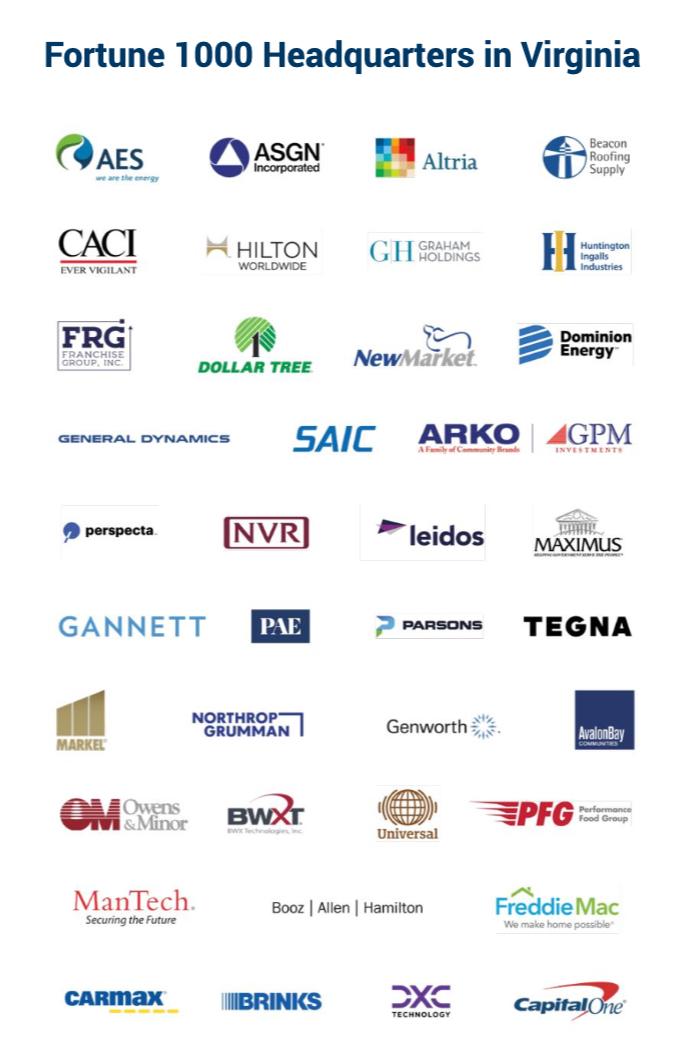
7
58 | Human Capital Career Trends
and one of our fastest-growing industries, thanks to investments by corporate partners (...)" said Governor Glenn Youngkin.




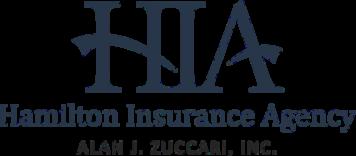


Aerospace and defense: Fairfax County is home to some of the biggest names in the defense and aerospace industry Key defense and aerospace systems engineering, cybersecurity, and homeland security companies are established in Virginia


Aerospace companies in Virginia flock to Fairfax County, taking advantage of the proximity to the Pentagon and other government agencies like the U.S. Department of Defense (DoD) and NASA.
Northrop Grumman, Lockheed Martin RollsRoyce in Fairfax County, BAE Systems USA, Raytheon, Boeing in Arlington, Airbus in Herndon, SAIC in Reston, and General Dynamics in Reston.









"Boeing's recent announcement to move its headquarters to Virginia and reaffirm its commitment to building the next generation of tech talent is a timely development for the Commonwealth and is made more exciting by their extensive partnership with Virginia Tech," said Governor Glenn Youngkin.



Source: https://www vedp org/key-industries

"Virginia has emerged "Virginia has emerged as one of North as one of North America’s premier America’s premier locations for technology locations for technology and Loudoun County is and Loudoun County is the epicenter of the data the epicenter of the data center industry." center industry."
Human Capital Career Trends | 59
SINCE JANUARY, 2022 THE FOLLOWING COMPANIES ANNOUNCED A NEW HEADQUARTERS IN VIRGINIA OR A RELEVANT EXPANSION OF THEIR OPERATIONS:
THE HUMAN RESOURCES INDUSTRY REPORT

Across the globe, almost all Human Resources leaders agree that the working environment is changing at a lightning-fast pace.
While most of the COVID-19 pandemic was marketed by a reactive approach and, in some cases, reactive solutions, the years ahead pose considerable challenges to these professionals
Most leaders are currently planning or implementing experimental strategies that focus on employees' mental health
The ones responsible for the healthcare industry face an additional challenge: a more competitive labor market. "Especially for uniquely qualified professionals, a situation that goes beyond the essential workers' sixteen sectors," explains Ana Paula Montanha, managing partner and co-founder of Hayman-Woodward Human Capital Services, a company located in Washington, D.C., focused on human resources services and management consulting. "Some organizations prepare to engage in a fierce competition to attract and retain talented employees, which requires them to expand their recruitment" she adds Her company is recruiting and retaining pilots, nurses, and licensed immigration attorneys, directly impacting the shortage of these talents in the United States' economy.
Over the last two months, May and June 2022, Human Capital - Career Trends magazine interviewed 103 global human resources leaders



leaders from small, medium, and large organizations and compiled the data.
On the next pages list the most significant trends and most meaningful challenges these leaders face:
1. Delivering a hybrid work employee experience

Rising employees' expectations of tailored workforce experiences while balancing employers' willingness to have all of them returning to their workplace
2. Implementing strategic people's planning and a crises ready organization
Human resources will be more demanded to prepare and lead organizations through multiple crises The pandemic showed how important having these senior executives, wellversed and prepared to lead, affects their operations and, consequently, their bottom line. Wise people's management, agility, and confidence are top board priorities
Human Capital Career Trends | 61
3. Developing people analytics insights and automation that drive business impact
People analytics in human resources teams must evolve to drive business impact across all organizations. Automation will free up these leaders' time to focus on matters, their people.

4 "All Together" will encompass so much more Many companies, especially the small and medium HR leaders, still believe they can do more regarding diversity, equity, and inclusion Leadership training to enhance cultural aspects will be keen for companies willing to grow internationally.
5. Attract, train, and please retain them! Almost all HR leaders agree that organizations and most developed nations will face increasing pressure to attract talented professionals and skilled specialists shortages. Retaining talent will be crucial to those willing to lead the industry.
challenging environment.
3. Promote a culture of "reengagement", with a more productive workforce. It is being able to created and develop a culture that helps everyone thrive. Mentoring programs, accelerate training systems, performance peer recognitions are some of the techniques used by Human Resources leaders

4 Implement a better and more comprehensive Human Resources system that addresses multicountry policies, rules and regulations – is a must for SMEs. Ana Paula Montanha, managing partner and co-founder of Hayman-Woodward Human Capital Services explains: " While in large organizations, the global human resources functional area deals with all aspects of HR within the worldwide context, including U.S. based entities doing business internationally or non-U.S. based entities operating in their own locale or worldwide, leaders in smaller firms that deals with import and export from abroad need information on how to practice human resources in a global economy Solutions tailor-made to their company size need to be developed"
We also condensed their most significant challenges for the same period.
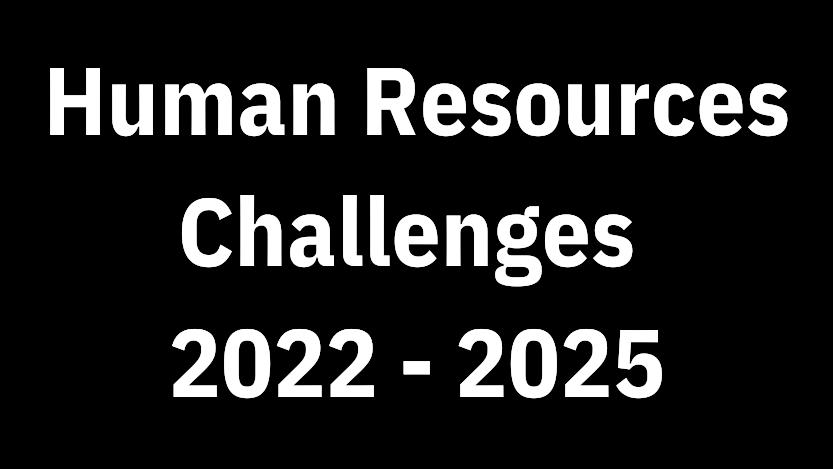
1. Understanding better how to address and prioritize employee mental health. Help employees tackle workplace burnout, and foster a sense of community and belonging which will promote a culture of "reengagement"
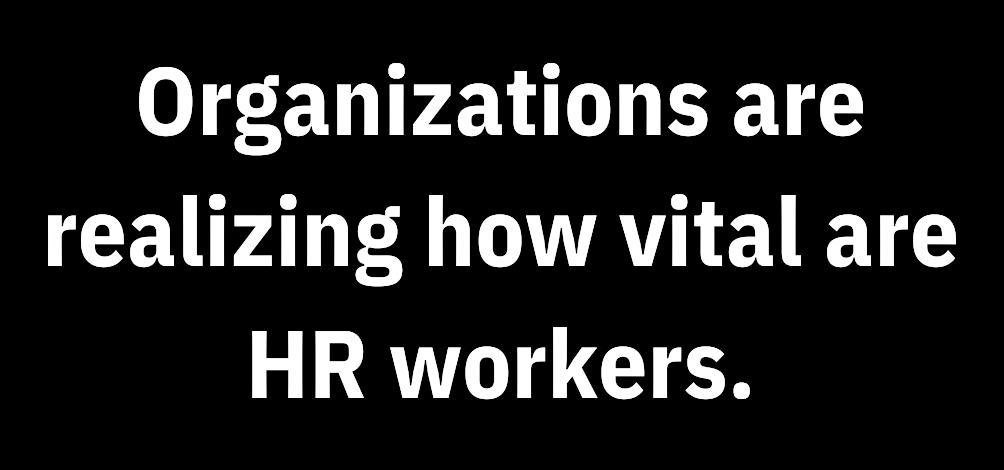
2 Winning the talent war, especially when talent is not present in their countries and licenses are required It turns out there may be no short-term solution. It is more than recruiting. Only a minority number of organizations have a well-defined and proactive strategies needed to ensure some level of predictability in their workforce pipelines in this
5 Prepare future leaders for other health-related crises Chances are that we will face other healthrelated crises in the future. Globalizations connects people in different geographies, and increase our dependency on each other. Human Resources leaders will need to look inward and make significant improvements in their ability to anticipate and respond to any future health emergencies.
Human Capital | Career Trends 5
62 | Human Capital Career Trends

Most influential global leaders are challenged to continue to evolve in the face of new priorities.

 Carlos Alberto Griner
Carlos Alberto Griner
Carlos Alberto Griner
Carlos Alberto Griner
OPENNESS, EMPATHY, LISTENING
Ana Paula Montanha, Editor-in-Chief
Human Capital - Career In this edition of Human Capital - Career Trends, we interviewed Carlos Alberto Griner, our selected Airspace and Defense Human Resources Global Leader to understand his perspectives on the Human Resources industry and trends.
Carlos Alberto Griner took over the position of Senior Vice President, People, ESG, and Communications at Embraer in June 2017, which incorporated Corporate Communications in 2018.
He began his career in the area of heavy construction and infrastructure and later migrated to quality management and human resources Griner has a degree in civil engineering from the StateUniversity of Rio de Janeiro, and an MBA from COPPEAD, the Federal University of Rio de Janeiro, Brazil.
What methods do you use to support employees who are experiencing mental challenges?
Firstly, it is important to acknowledge that mental challenges are a serious issue that unfortunately increased during the pandem in all businesses
Companies need to offer or expand the psychological support to employees who need it and guide leaders and their team on how to deal with the situation, whether through webinars, educational campaigns, training as well as offering sports or social activities to reduce anxiety and increase team engagement.

We also need to find the balance between productivity and well-being, respecting the rhythm of each one. The company has to be open and flexible to find the best solution, experimenting with initiatives, and prototyping ideas.
How did your techniques to develop the leadership styles of your managers improve during the pandemic?
At Embraer, we optimized our digital tools to foster productivity and strengthen communication within teams and between areas. Openness, empathy, and active listening were the main skills, especially working 100% remotely.
Human Capital Career Trends | 65
LEADERS NEED TO BE CLOSER TO THEIR EMPLOYEES AND CREATE AN ENVIRONMENT OF TRUST AND ATTENTION TO ANY SYMPTOMS.
What has been the greatest lesson you've learned as a human resources leader in the last three years?
For me, the most important lesson was the importance of dedicating more time to explain the “why” to the team. The leader's role is to be humble, and vulnerable and find time in the busy agenda to be close to the team and carry out the explanations that precede “what” and “how”.
Doing that, our teams will understand the context and the reasons why we are demanding them to do the task or project. Then, they will not only deliver it but overcome our expectations

That is why is so important to have leaders with empathy, active listening, and who are close to their employees to create an environment of trust and belonging.
Carlos Alberto Griner's key lessons:
1. Be open to your team, be close, so you can be "there for them".
2. Make sure you explain the “why” to the team. The leader's role is to be humble, and vulnerable, find time in the busy agenda to be close to the team, and carry out the explanations that precede “what” and “how”.
2. Choose leaders that have empathy, who are active listening, and who are close to their employees to create an environment of trust and belonging.
66 | Human Capital Career Trends
OPENNESS, EMPATHY AND ACTIVE LISTENING WERE THE MAIN SKILLS, ESPECIALLY FOR WORKING 100% REMOTELY.
Laurie Riker Laurie Riker

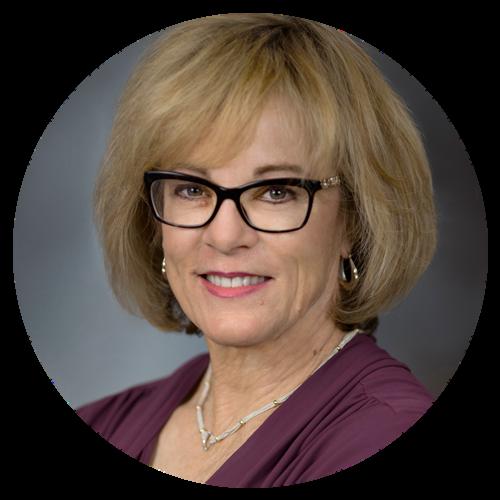

ALLOW FOR THE HEART OF OUR LEADERSHIP TO SHINE THROUGH.
Elaine Dotto, Journalist.
In this edition, Human Capital - Career Trends interviewed Laurie Riker, our selected Airspace and Defense Human Resources Global Leader to understand his perspectives on the Human Resources industry and trends
Laurie Riker, SPHR, is an accomplished Human Resources Executive, and international best-selling author.
She has worked for over 25 years in Senior HR Leadership roles for a variety of fortune 50 companies and startups in hi-tech, bio-tech, consulting, finance and not-for-profit She holds an MSW, concentration in Counseling, from Rutgers University and a Bachelor of Science in Business Administration from Cal State University. She is a certified Executive Coach, Certified Leadership and Diversity Trainer, and trained Professional Speaker. Laurie has facilitated numerous motivational workshops and has led HR best practice segments of Win-Win Radio. Laurie is also an international best-selling author of the book “Women Who Influence” .
What methods do you use to support employees who are experiencing mental challenges?
We have all experienced challenging times in our lives, particularly the last couple of years, with extenuating stressors above and beyond the normal. This ties directly to job stress and mental health. As an HR professional, I understand that the relationship between people and how they view work has probably changed forever.
It has been recorded that 4.4 million people left their jobs in the last year. There is a paradigm shift in what employees expect from their employers.
It is imperative during high-stress times to ensure the wellbeing of our employees. We deployed pulse surveys as an effective tool to understand where our employees are/were on the mental health continuum and how we could support them.
Our employee responses resulted in the following actions
Pulse
a. Implementing/announcing our support for a flexible work schedule.
b. Working with our leaders to continuously build rapport with all teammates. Ensuring a 1:1 meeting was scheduled weekly
c. Human Resources emphasized mental health support through outdoor resources, open-door policies, and confidential discussions for all employees.
d. Human Resources initiated wellness checks with all employees via phone and or video chat (our employees wanted to feel we cared about them).
e. Company communications were stepped up, newsletter frequency increased, and communications about community health issues and resolutions were sent out weekly
f. Human Resources facilitated more opportunities for our employees to feel a part of a community by creating committees to move company initiatives and learning opportunities forward and part of the culture.
68 | Human Capital Career Trends
How did your techniques, to develop the leadership styles of your managers, improve during the pandemic?
During the pandemic the acumen/leadership styles of our leaders was highlighted/tested. Our leadership team was mostly young in their role and being suddenly forced to lead an empty chair was daunting for most of the team. Our challenge, to retain our top talent, to provide the support and tools needed for leading effectively.
We assessed the current skillset of our leadership team and created and facilitated an interactive/experiential “Emerging Leaders” Training Program. All participants agreed to the guidelines and being accountable for assigned readings/work-plays and topic presentations. All participants were required to schedule 1:1 one coaching sessions with the in-house Executive Coach.
Some of the topics included the following.
a. Leading vs managing
b Coaching skills (active listening, trusting)
c. Transparency
d. Providing Effective Feedback (HR created a model)
e. Accountability
f. Difficult conversations
g Leadership styles
h. Delegation
Program Success- The success of the program was measured by the participant’s final project. They were tasked with presenting their learnings and implementation of skills in front of a very supportive Executive Team.
Human Resources got to witness the transformation of these employees, from tentative to confident leaders. We also learned that our dedication to the graduate's professional development was a critical ingredient for the program's success!
WE ALSO LEARNED: OUR DEDICATION TO THE GRADUATE’S PROFESSIONAL DEVELOPMENT WAS KEY FOR THEIR SUCCESS.
What has been the greatest lesson you've learned as a human resources leader in the last three years?
The greatest lesson I have learned in the last five years + as a Human Resource Leader is simply this; our people/teammates need us to see and treat them as human beings first, not just another cog in the wheel I believe as a practice; human resource professionals have moved away from being employee advocates. We need to be employee-centric and treat our precious commodities with outmost care. Now more than ever, we as Human Resource leaders and role models, need to allow for the heart of our leadership to shine through.
Human Capital Career Trends | 69

IMMIGRATION CAREER PLANNING PROFESSIONAL CURRICULUM VITAE DIPLOMA VALIDATION AND CERTIFICATIONS PERSONAL ASSET BUILDING BUSINESS CONSULTING BUSINESS PLANS RECRUITMENT PROFESSIONAL STAFFING EMPLOYER OF RECORD OUR SERVICES HAYMAN-WOODWARD HUMAN CAPITAL Office: +1(202)753-4133|E-mail:HC@HW.IM
YOU'RE INVITED TO THE YOU'RE INVITED TO THE GRAND OPENING GRAND
Please join us in celebrating our Inaugural ceremony on Thursday,14TH JULY 2022 RSVP for more information: HC@HW.IM


14 14 JULY JULY tth h
HW HW
OPENING ORLANDO ORLANDO
Subscription:

Customer Services: customerservice@humancapitalcareertrends.com
subcribe@humancapitalcareertrends.com
info@humancapitalcareertrends.com
https://hwhuman.capital/career-trends/ YOUR LOGO HERE
Editorial:
Domain:




































 Ana Paula Montanha.
Ana Paula Montanha.

 CEO, Hayman-Woodward
CEO, Hayman-Woodward

















































 COO, Hayman-Woodward
COO, Hayman-Woodward




 Andre Merlino
Global Senior Executive, and Energy Expert
Andre Merlino
Global Senior Executive, and Energy Expert
 Andre Merlino
Andre Merlino





































 Carlos Alberto Griner
Carlos Alberto Griner
Carlos Alberto Griner
Carlos Alberto Griner













